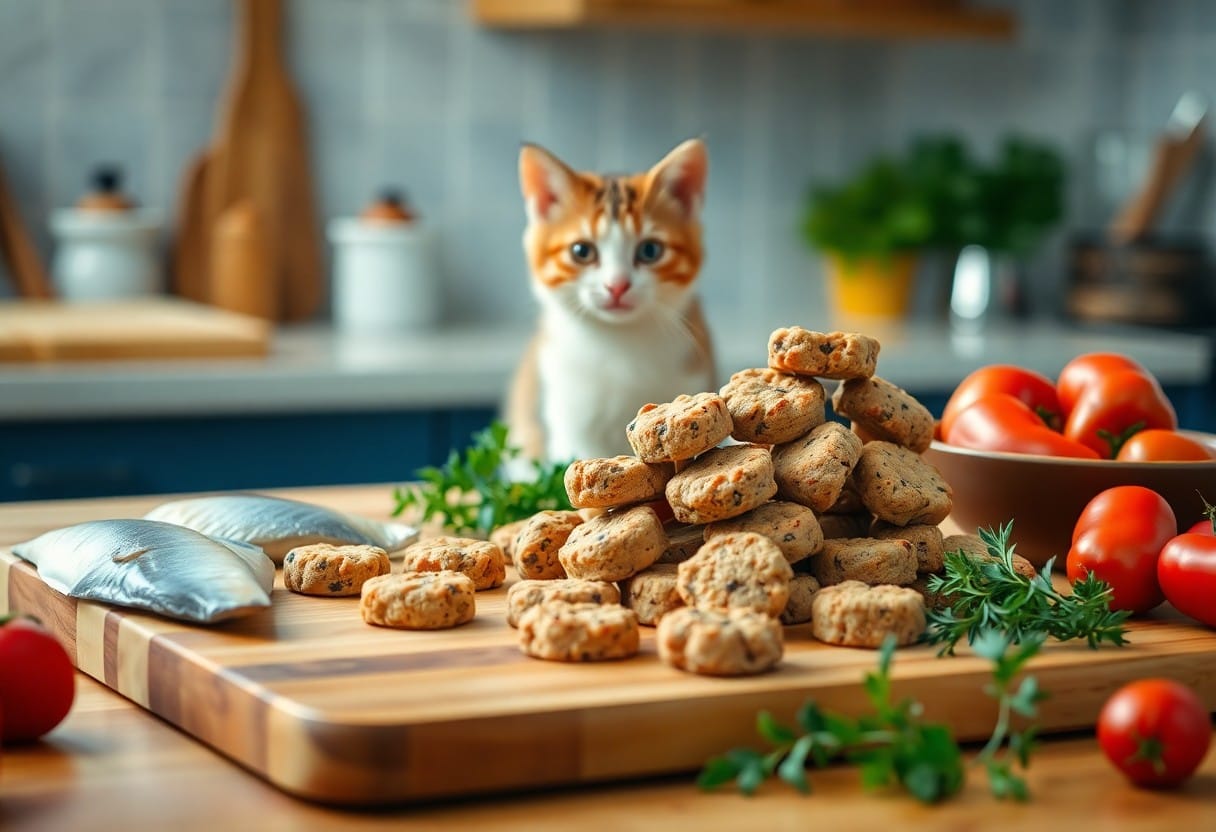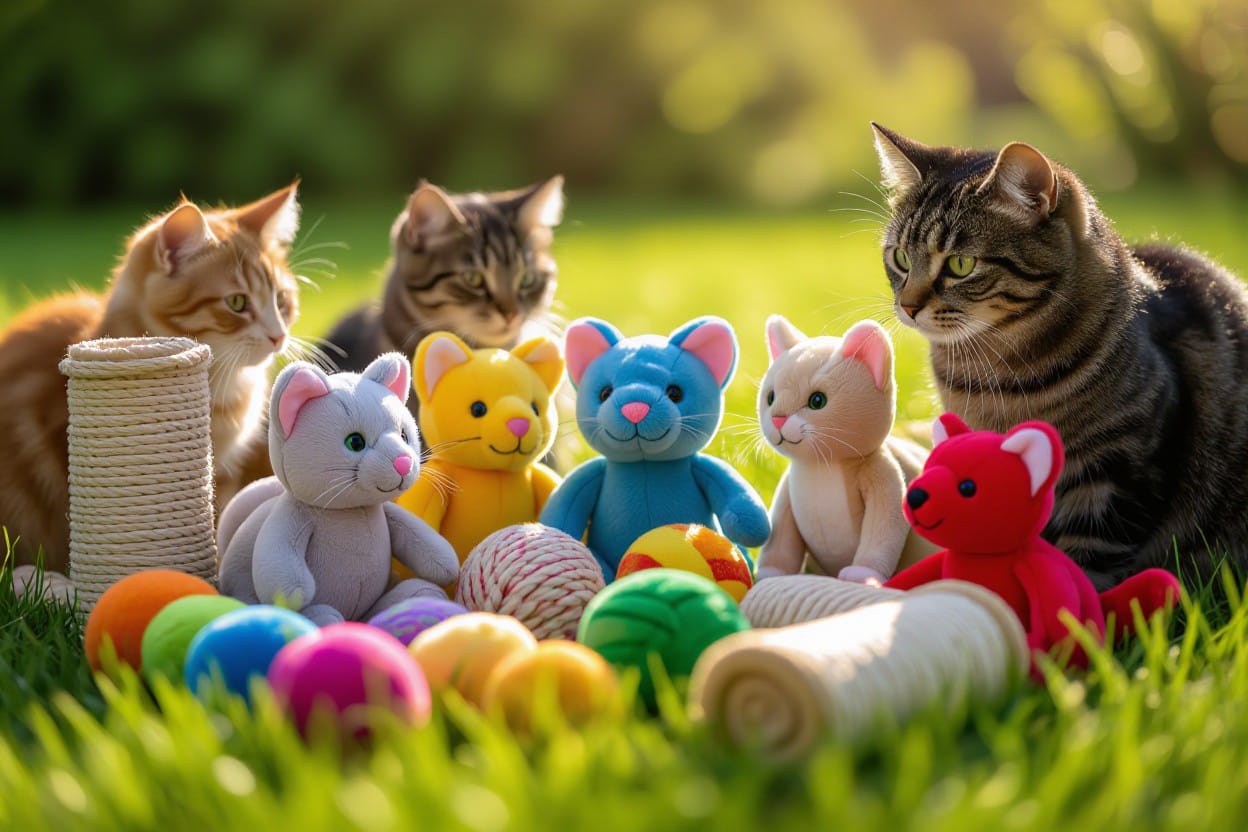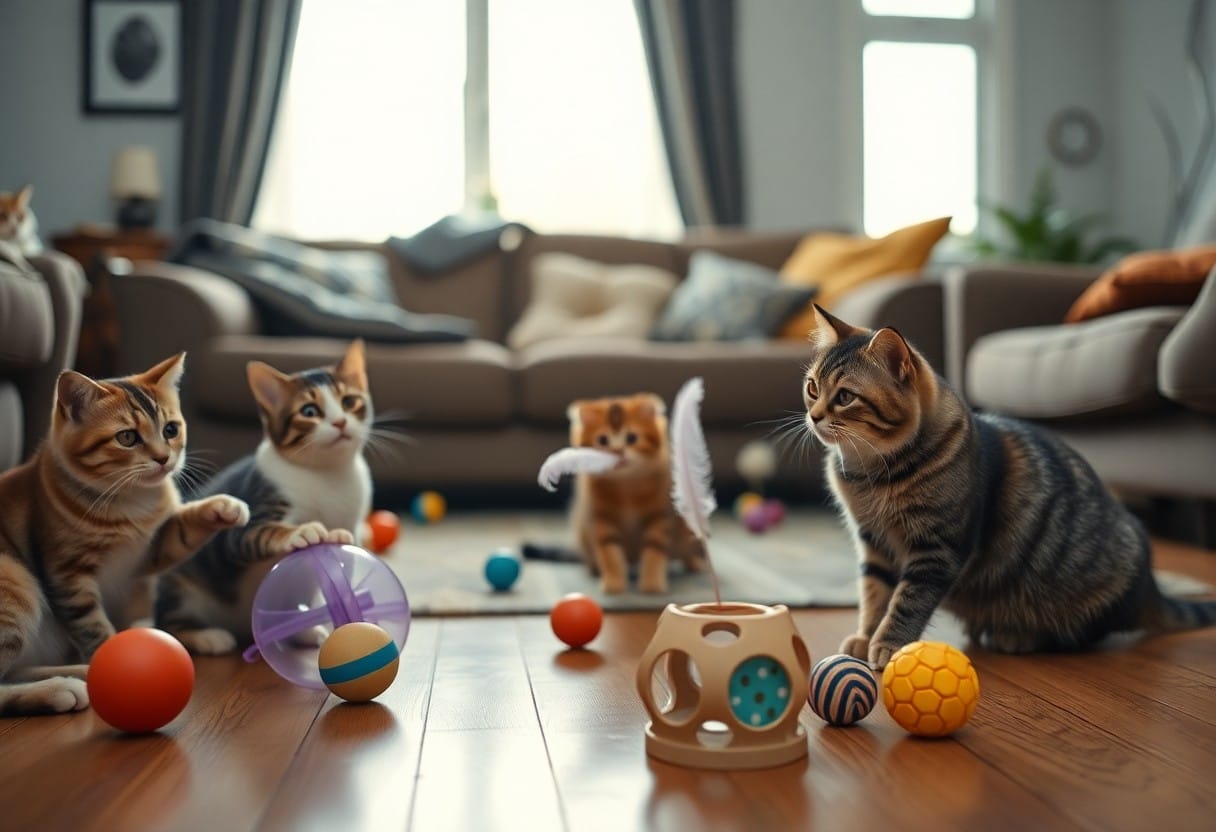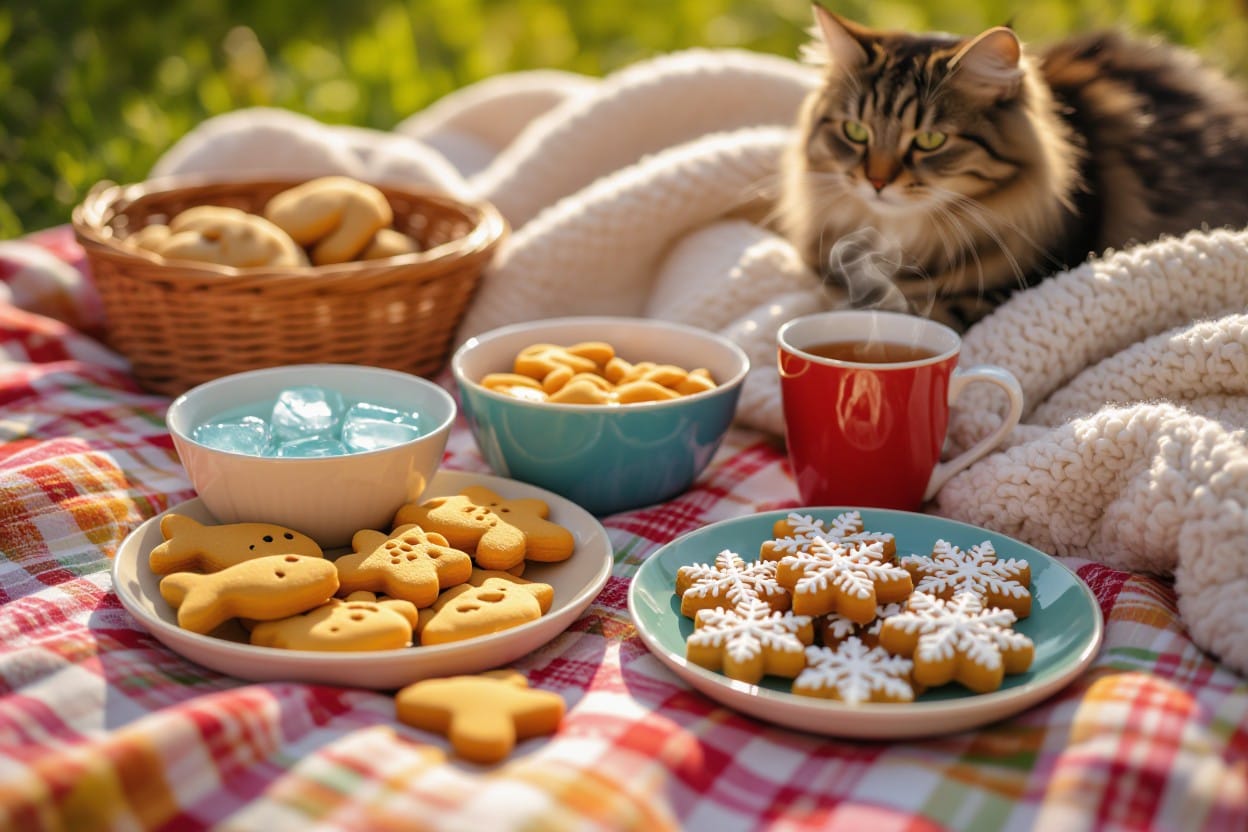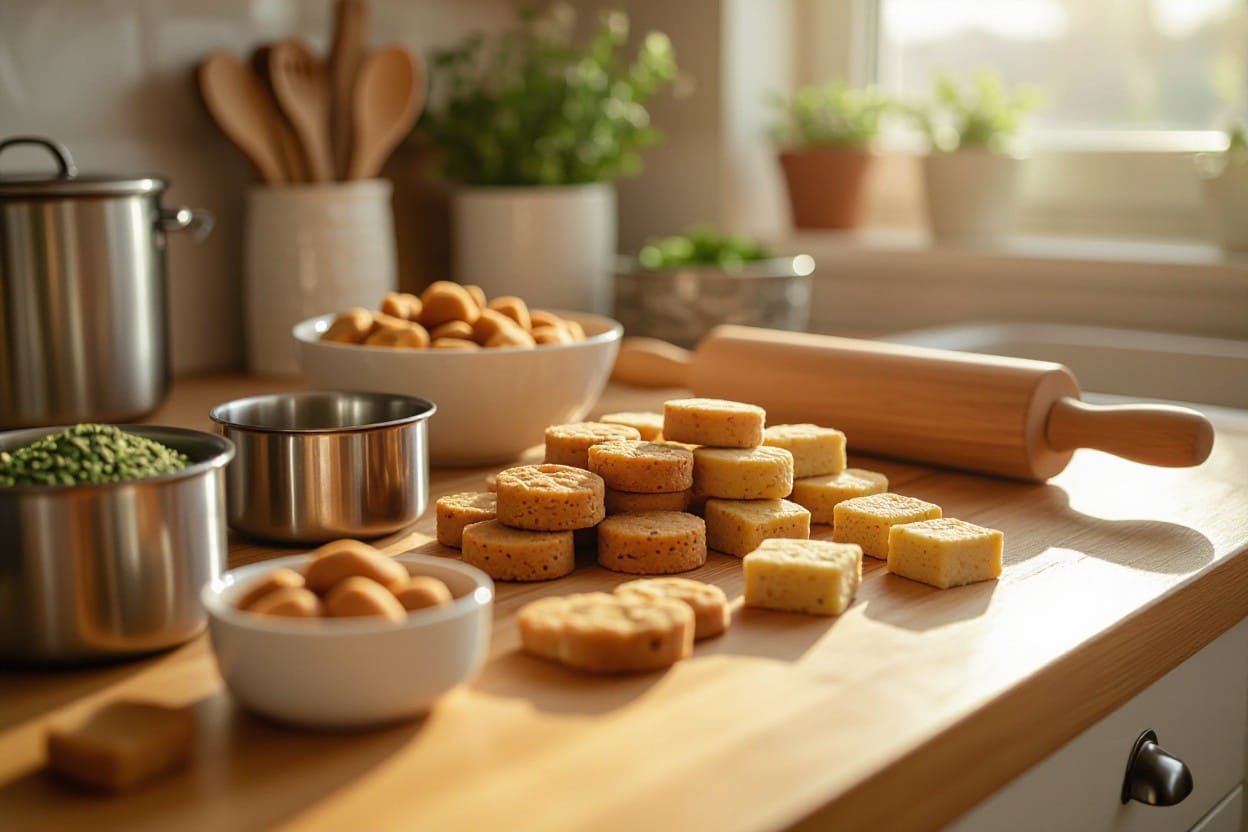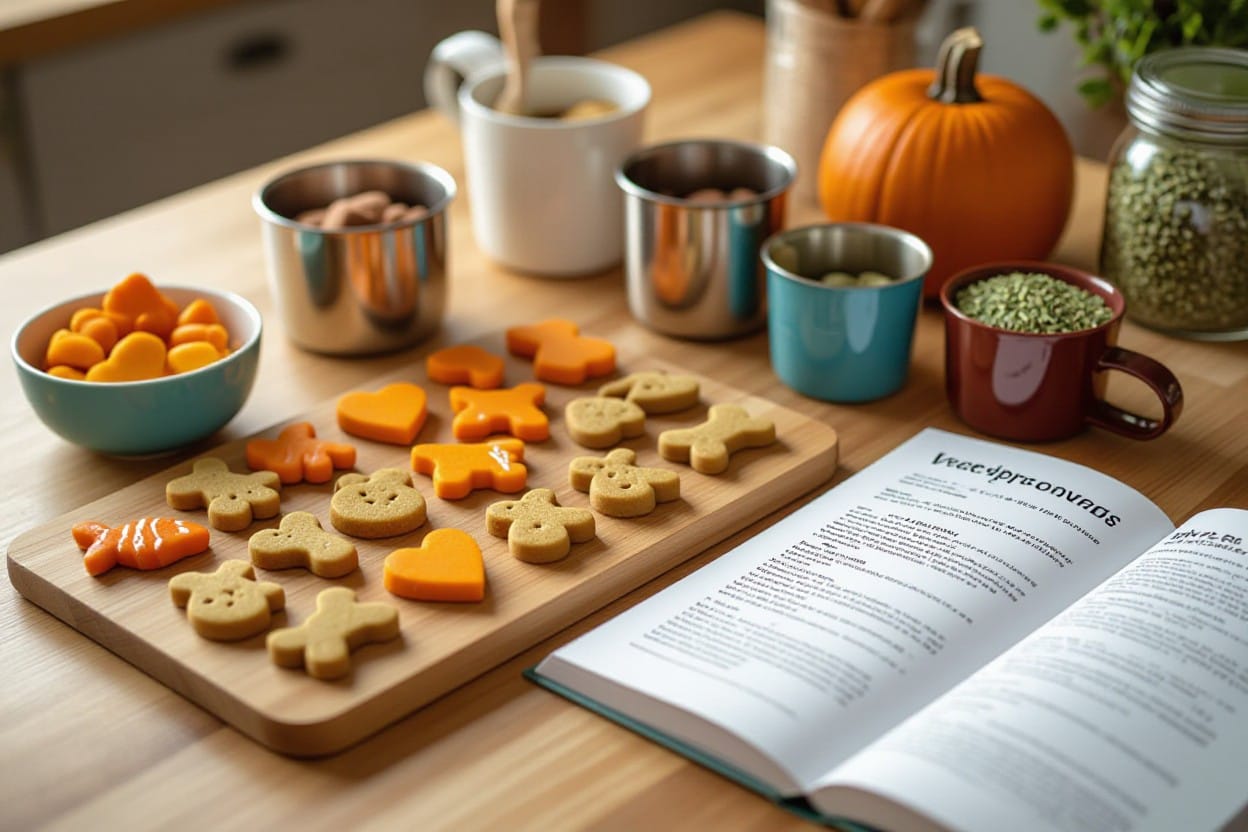Homemade cat treats not only allow you to control the quality of ingredients but also ensure that your feline friend enjoys natural and nutritious snacks. By crafting these treats yourself, you can avoid harmful additives and preservatives often found in commercial products. Plus, creating unique flavors tailored to your cat’s preferences fosters a closer bond between you and your pet. Investing a little time in making your own treats can lead to healthier, happier cats that are less prone to dietary issues. Discover how easy and rewarding it is to whip up these delightful goodies at home!
Key Takeaways:
- Homemade cat treats allow you to control the ingredients, ensuring they are natural and free from harmful additives or preservatives.
- Creating your own cat treats can cater to your pet’s specific dietary needs or preferences, promoting better health and well-being.
- Making treats at home can be cost-effective and a fun activity that strengthens the bond between you and your cat.
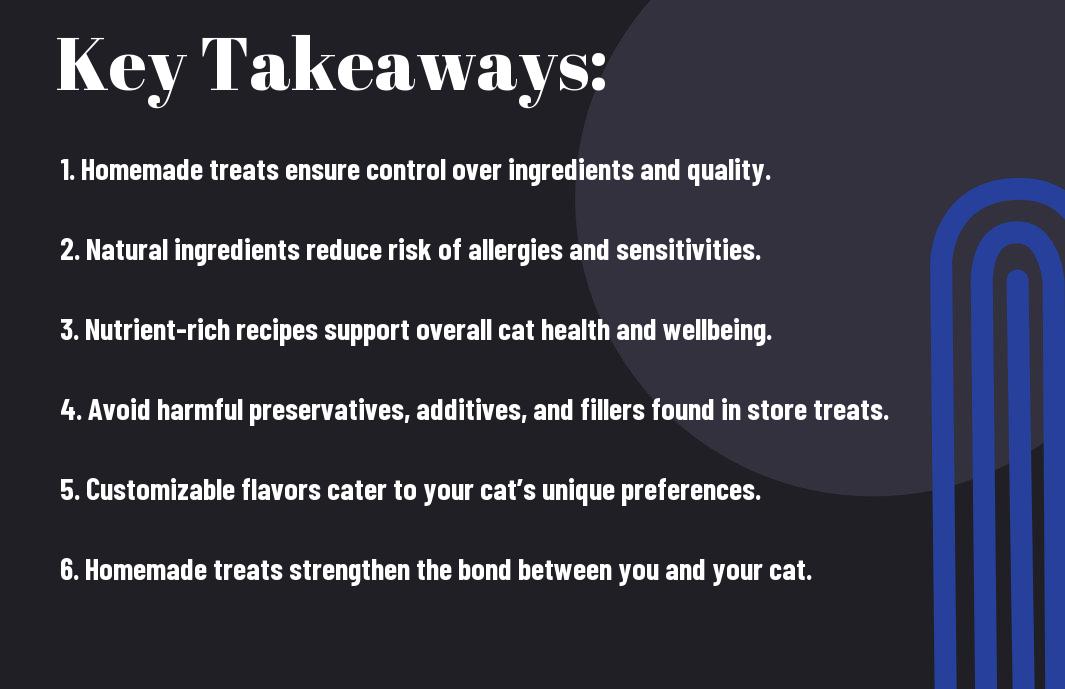
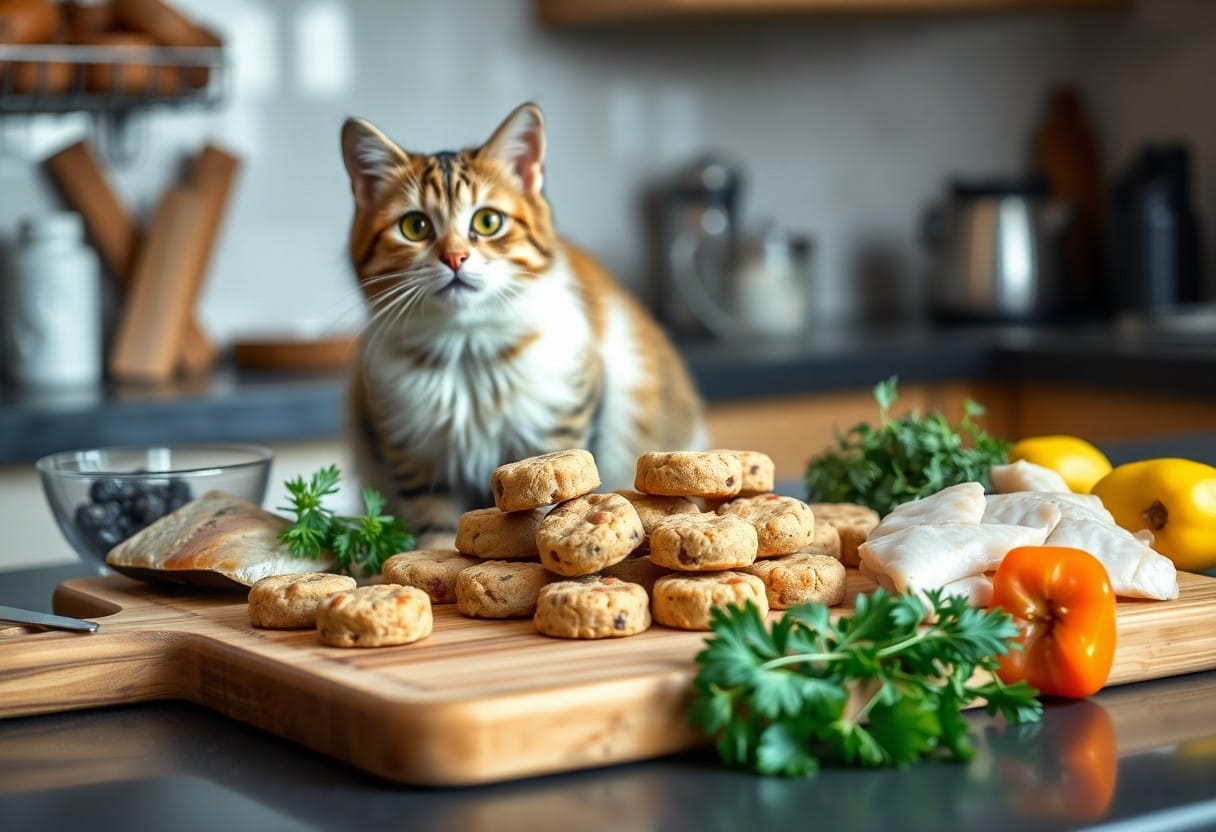
The Benefits of Homemade Cat Treats
To provide the best for your feline companion, making homemade cat treats offers numerous benefits. You have complete control over the ingredients, ensuring they are natural, healthy, and free from harmful additives. This not only promotes better overall health for your cat but also enhances their enjoyment of mealtime. Plus, your homemade creations can strengthen the bond between you and your cat, making treat time a special part of your routine.
Healthier Ingredients
After opting for homemade cat treats, you can incorporate fresh, wholesome ingredients that are beneficial to your cat’s health. Avoiding artificial preservatives, fillers, and low-quality components means your treats will be made from high-quality sources. This leads to better digestion and nutrition for your pet, minimizing the risk of allergic reactions or health issues often seen with commercial treats.
Customizable Nutrition
An vital advantage of homemade cat treats is the ability to customize nutrition according to your cat’s specific needs. Every cat is unique, and some may require tailored diets due to age, health conditions, or dietary preferences. You can adjust the ingredients to accommodate various requirements such as lower fat, higher protein, or hypoallergenic options, ensuring your pet receives the right nutrition for their individual lifestyle.
At home, you have the flexibility to experiment with different nutrition profiles that cater to your cat’s unique needs. For instance, if your kitty is prone to weight gain, you can focus on low-calorie ingredients like shredded chicken or fish, while still ensuring they receive vital vitamins and minerals. Alternatively, if your cat is a senior with specific health issues, you might include ingredients that promote joint health or boost their immune system. The ability to personalize treats means you can provide the best care possible, supporting your cat’s health and happiness with every bite.
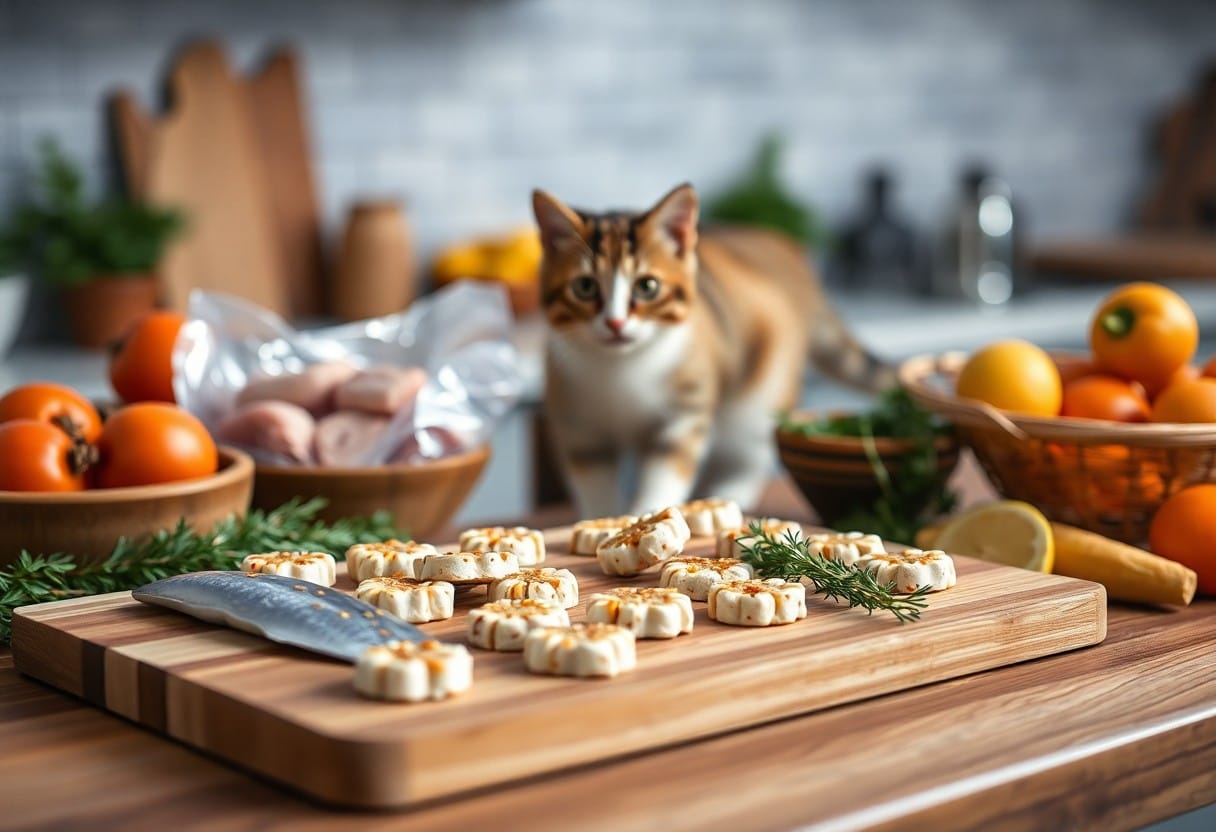
Common Ingredients for Homemade Cat Treats
The best homemade cat treats typically include a mix of wholesome ingredients like chicken, tuna, pumpkin, and various cat-safe herbs. These ingredients not only cater to your cat’s palate but also provide vital nutrients that contribute to their overall health. Utilizing fresh, natural components ensures that you know exactly what your pet is consuming, promoting a balanced diet tailored to their needs.
Safe and Nutritious Options
Common choices for healthy cat treats incorporate proteins such as cooked chicken or fish, along with vegetables like sweet potatoes and peas. You can also use oat flour or brown rice to bind the mixture, ensuring a delightful texture that your feline friend will appreciate. Adding catnip can enhance flavor and enjoyment, making your homemade treats a hit!
Foods to Avoid
Avoid ingredients that could be toxic or harmful to your cat. Foods such as chocolate, onions, garlic, grapes, and raisins are known to pose serious health risks. These items can cause gastrointestinal upset, kidney failure, or even death in cats. Always double-check any ingredient you consider using in your recipes to ensure your furry friend remains safe and healthy.
Always prioritize your cat’s well-being by steering clear of these dangerous ingredients. Foods like chocolate are highly toxic, while items such as onions and garlic can damage their red blood cells, leading to anemia. Grapes and raisins are also notorious for causing kidney failure in cats. By being mindful about what goes into your homemade treats, you can ensure that they’re not only delicious but also safe.
Easy Homemade Cat Treat Recipes
Keep your feline friends happy and healthy with these simple homemade cat treat recipes. Crafting treats at home allows you to control the ingredients and ensure they’re nutritious. You’ll find that preparing these delicious snacks can be both easy and fun, giving you the satisfaction of knowing exactly what your cat is consuming.
Simple Fish Treats
Above all, you can whip up these delectable Simple Fish Treats in no time. Using canned tuna or salmon, combine it with whole wheat flour and form small doughy bites. Bake until golden, and your cat will be purring in no time!
Chicken and Pumpkin Biscuits
Fish lovers will find joy in these Chicken and Pumpkin Biscuits that incorporate two wholesome ingredients your cat will adore.
Indeed, these Chicken and Pumpkin Biscuits are a fantastic option for your cat’s diet. Combining shredded chicken with pure pumpkin and some whole wheat flour, you’ll create a nutritious treat. Pumpkin provides important nutrients and is gentle on your cat’s digestive system, while chicken offers a protein boost. Make sure to bake them until they’re crispy, making them irresistible for your furry companion. Always ensure the ingredients are safe and suitable for your cat’s dietary needs to keep their health in check.
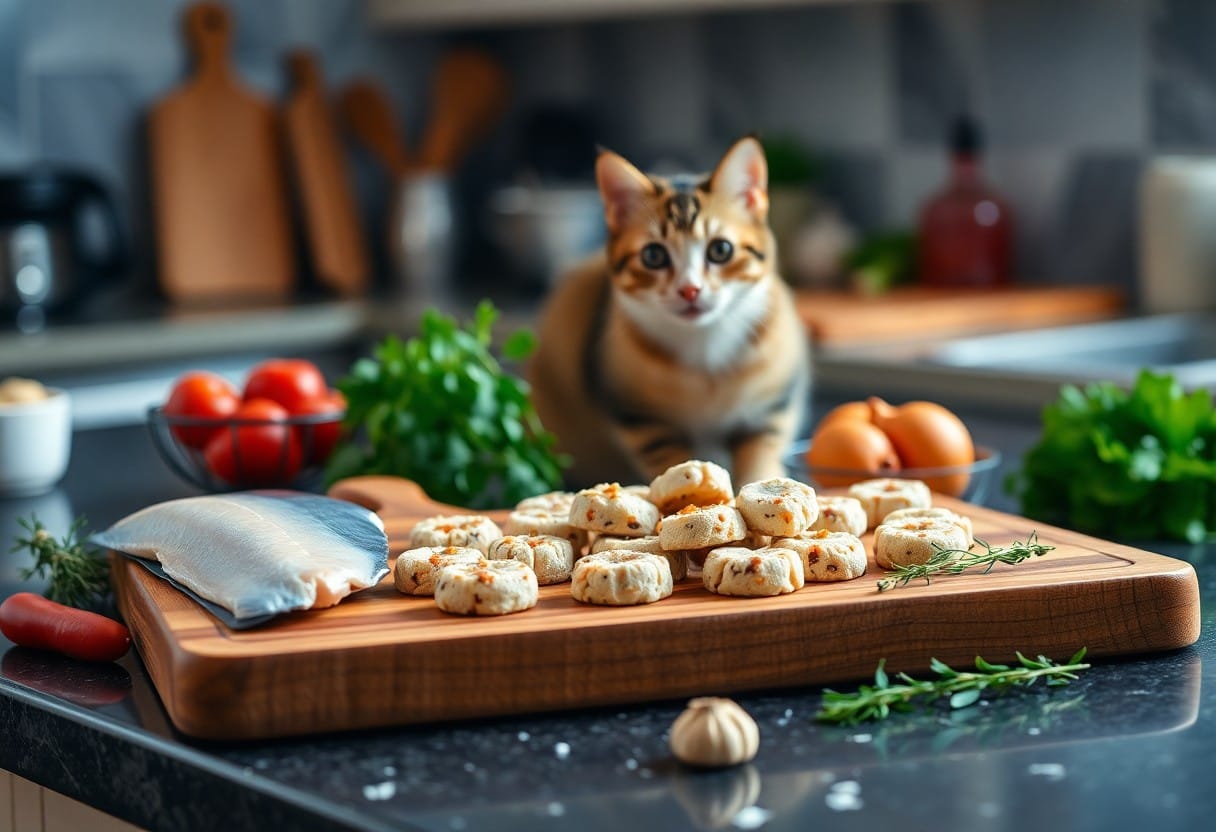
Tips for Storing and Serving Treats
Many cat owners find it beneficial to use safe and effective methods for storing and serving homemade cat treats. To keep them fresh and tasty, consider the following tips:
- Store treats in an airtight container.
- Keep them in a cool, dry place.
- Label containers with the preparation date.
- Serve treats promptly to maintain flavor.
Recognizing these best practices ensures your furry friend enjoys the healthiest and most flavorful treats.
Proper Storage Techniques
Any homemade treat you prepare should be stored properly to maintain its freshness and nutrient content. Use airtight containers, preferably glass or plastic, and ensure that they are kept in a cool and dry area of your home. If you’ve made a large batch, consider freezing some of them to extend their shelf life, and always label your containers with the date of preparation.
Serving Sizes and Frequency
Below, it’s imperative to consider the serving sizes and frequency of your homemade treats. Treats should only make up a small portion of your cat’s daily caloric intake, typically around 10%. Keeping this in mind will help you maintain your cat’s health and weight.
But, pay attention to your cat’s reaction to new treats; monitor for any signs of allergies or digestive issues. While homemade treats are often healthier, too many can lead to weight gain. Aim for one to two treats per day, and adjust the quantity based on your cat’s age, weight, and activity level. This way, you ensure that your cat stays happy and healthy while still enjoying delicious homemade snacks.
Addressing Common Concerns
Not every cat is the same, and you may have concerns about making the switch to homemade treats. While homemade treats can be healthier, it’s important to consider factors such as allergies, sensitivities, and how to smoothly transition your cat to a new diet. This chapter will help you navigate potential issues and enjoy making nutritious snacks for your feline friend.
Allergies and Sensitivities
Sensitivities to certain ingredients can affect your cat’s health. When making homemade treats, keep a close eye on any known allergies your cat may have, such as gluten or specific proteins. By choosing fresh, wholesome ingredients and avoiding common allergens, you can create treats that cater to your cat’s unique dietary needs.
Transitioning Your Cat to Homemade Treats
Behind every successful transition to homemade treats lies a careful approach. Start by introducing homemade treats gradually, allowing your cat to adjust to the new flavors and textures. Monitor their reaction closely, ensuring they enjoy the treats without any adverse effects. Avoid sudden dietary changes, which can upset their stomach, and introduce one new treat at a time. Patience is key, as some cats may need time to accept new foods. Always consult with your veterinarian if you notice any cravings or discomfort during this transition process.
In addition, you can make the transition smoother by mixing a small portion of homemade treats with their regular treats, gradually increasing the homemade ratio over time. This familiarizes your cat with the new flavors while reducing any digestive upsets. Ensure you choose ingredients that are natural and safe for cats, focusing on their unique needs, and observe their preferences. By taking these steps, you’ll make their adjustment to homemade treats an enjoyable experience for both you and your furry companion!
Encouraging Positive Behavior with Treats
After you have prepared some delicious homemade treats, you can use them to effectively encourage positive behavior in your cat. Treats can serve as an excellent incentive during training sessions, fostering a strong bond between you and your feline friend while promoting desirable actions. By rewarding your cat for good behavior, you help them understand what actions are expected and reinforce those behaviors through positive reinforcement.
Training with Treats
Treats are an excellent tool for training your cat, as they create a positive association with specific commands or actions. By offering a small, tasty reward whenever your cat follows your instructions, you reinforce their willingness to learn and adapt. Whether it’s teaching your cat to sit, come, or even use the litter box, treats provide a motivational boost that enhances the learning experience.
Reinforcing Good Habits
By regularly rewarding your cat’s good habits with tasty homemade treats, you’ll foster a sense of accomplishment and trust. Treats can help establish routines such as using the litter box or scratching designated areas. When your cat receives a treat after successfully completing these tasks, it reinforces their understanding of expectations. This encourages them to repeat these actions consistently, aligning their behavior with your guidelines.
Treats play a vital role in reinforcing good habits, as they act as positive feedback for your cat. When your cat receives a homemade treat for appropriate behavior, you not only communicate approval but also strengthen the bond you share. This connection encourages your cat to repeat the behavior, increasing their overall compliance and speed of learning. By integrating treats into your training regimen, you emphasize a nurturing approach that contributes to your cat’s long-term behavioral success.
Final Words
On the whole, making homemade cat treats is the best choice for you and your feline friend because it ensures natural ingredients without harmful additives. By crafting these tasty snacks, you have complete control over what goes into your cat’s diet, promoting their overall health and well-being. You can tailor the recipes to suit your cat’s preferences and dietary needs, making treat time a nutritious experience. Plus, the bond you strengthen with your cat during this process adds immeasurable joy to both your lives. Choose homemade treats for a happier, healthier kitty!
FAQ
Q: What are the benefits of making homemade cat treats?
A: Making homemade cat treats allows pet owners to control the ingredients, ensuring that the treats are natural and nutritious. This means no preservatives or artificial additives that can be harmful to your cat’s health. Additionally, you can tailor the treats to your cat’s specific dietary needs and preferences, which can help manage allergies and weight. Homemade treats can also be a fun way to bond with your feline friend, as they often enjoy the experience of fresh and tasty homemade goodies.
Q: What ingredients are best for homemade cat treats?
A: Ideal ingredients for homemade cat treats include high-quality proteins like lean meats (chicken, turkey, or fish), eggs, and certain dairy products that are safe for cats, such as cottage cheese. You can also add healthy carbohydrates like pumpkin or sweet potatoes, which are nutritious and provide fiber. Be cautious to avoid toxic foods like onions, garlic, chocolate, and certain artificial sweeteners. Always research or consult a vet for the best choices for your cat’s diet.
Q: How do I ensure the homemade cat treats are safe and healthy?
A: To ensure the safety and healthiness of homemade cat treats, start by using fresh, high-quality ingredients and following reliable recipes that are specifically designed for cats. It’s also necessary to adhere to proper food handling and cooking practices to avoid contamination. Gradually introduce new treats into your cat’s diet, observing for any allergic reactions or digestive issues. Lastly, consult with a veterinarian for personalized advice, particularly if your cat has pre-existing health conditions or dietary restrictions.
